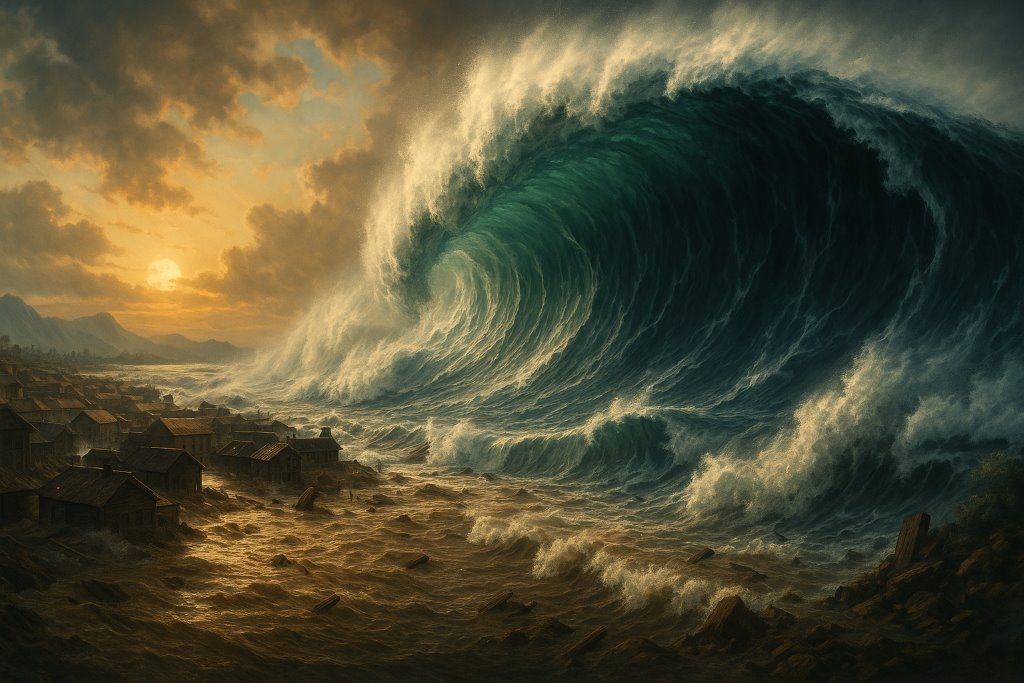
Biggest Tsunami Ever Recorded: Deadliest Waves in History
The sea keeps secrets, and not gentle ones. When people ask about the biggest tsunami ever recorded, the mind goes to numbers first – heights, speeds, distances. Yet the part that stays with you is different. It is the sound of walls giving way, the long pull of water rushing out before the first surge, the strange quiet that follows. I think stories help more than figures alone, so this piece starts with scenes and then circles back to the mechanics. By the end, the phrase biggest tsunami ever recorded stops feeling like a dry label and starts sounding like a warning we inherited from those who stood on the wrong shoreline at the wrong moment.
Across centuries, coastlines have been rewritten in minutes. Some events stretched across entire ocean basins. Others stayed tucked inside a bay yet climbed higher than anything humans had ever witnessed. In the same way people trace the Mayan civilization timeline to understand cultural peaks and collapses, tracing these water-driven catastrophes reveals how natural forces bend history itself.
When looking at the biggest tsunami ever recorded, statistics underline the scale. The tallest wave measured reached 1,720 feet in Lituya Bay. The most widespread, the Indian Ocean event of 2004, killed more than 230,000 people across 14 countries. The 1964 Alaska event reached a magnitude 9.2 earthquake and waves over 220 feet. These figures show why numbers are as memorable as the stories – they rank among the largest natural forces humans have ever seen.
The Alaska Tsunami Disaster

The Alaska tsunami most people remember arrived on March 27, 1964, in the wake of a magnitude 9.2 earthquake. Evening sky, chill air, and then the ground started moving in long waves that seemed to last forever. In coastal towns, docks twisted, fuel tanks ruptured, and lights went out. A series of surges followed, not just one. In places around Prince William Sound, water heights reached levels that reshaped harbors and lifted buildings from their foundations.
Valdez saw a waterfront collapse that pulled people and machinery into the bay in an instant. In Anchorage, damage came mostly from the shaking, but across the region, small communities felt the ocean’s reach in a way that still shows in old photographs – boats left in the middle of streets, pylons bent like wire, houses pushed inland and left at odd angles. Hours later, the waves kept moving, and Crescent City, California, far down the coastline, took a direct hit that killed residents and chewed through a downtown built on fishing and trade.
What stays with me in survivor accounts is the rhythm. A first surge, then a pause long enough to feel like it might be over, then another blow. Families fled to higher ground in the dark with little information and made choices in minutes that decided whether they lived. The number of dead was lower than some other tragedies, yet the pattern of destruction stretched across a continent’s edge, revealing how far energy can travel once the sea is pushed out of balance. The lessons that followed reshaped coastal planning and warnings, but the memory of that night still carries more weight than any later memo or report.
The 1964 quake released energy equivalent to about 12 million tons of TNT. Waves in Prince William Sound climbed above 220 feet, while Crescent City in California saw surges around 11 feet that still managed to kill 12 people. Monetary damage estimates topped $2.3 billion in today’s value, placing the Alaska tsunami high on any list of destructive events in North America.
Lituya Bay Mega Tsunami: The Tallest Wave Ever

The Lituya bay mega tsunami remains the tallest wave ever measured by people. The setting was a narrow, deep inlet in Alaska with steep rock walls and a history of violent landslides. On July 9, 1958, an earthquake struck, a cliff gave way, and a vast chunk of mountain slammed into the water. In seconds, the bay responded with a surge that scraped hillsides bare and left a stark trim line more than 1,700 feet above normal sea level. That number is hard to picture, so I keep translating it in my head – taller than many skyline towers, taller than most of what we build anywhere.
Two small boats were inside the bay. One was carried up and over a forested ridge line, then dropped into the water on the far side. The crew lived, though their story reads like a scene pulled from somewhere unreal. The other crew wasn’t as fortunate. Trees were ripped out, soil removed down to bedrock in places, and the bay’s geometry focused the force like a funnel. People sometimes compare this event to ocean-crossing tsunamis, but it sits in a category of its own. It did not travel far. It did not sweep across borders. It rose inside a single inlet to a height that still feels beyond what our senses want to accept.
There is a quiet lesson here too. Many coastlines hide narrow coves and fjords with steep walls. When rock fails and drops into confined water, the result can be wildly out of scale with the size of the bay itself. That is why a local event can produce a peak that rivals, in height if not reach, the legends tied to the biggest tsunami ever recorded in popular memory. The difference lies in distance covered, not in the raw vertical scar left on the land.
The Lituya bay mega tsunami stripped forests for more than 5 square miles, flattening trees as if they were grass. Scientists later measured the trim line at 1,720 feet – nearly three times the height of the Eiffel Tower. Though casualties were limited, the sheer measurement makes it the highest wave in recorded history, an unmatched record even compared with ocean-crossing tsunamis.
Tsunami 2004: The Indian Ocean Disaster

Tsunami 2004 is etched into the world’s memory for a different reason – lives lost across many countries on a single morning after a massive earthquake off Sumatra. Magnitude estimates sit in the low 9s, and the rupture lasted long enough for people to feel fear turn into something else, a kind of stunned waiting. Then the sea withdrew from beaches, revealing fish flopping on wet sand. Children ran toward the novelty. A few older voices yelled to move inland. Minutes later, the water returned, and then kept coming.
In Indonesia’s Aceh province, villages vanished. Sri Lanka and India saw long coastlines swallowed. Thailand’s resorts turned into rescue sites in a single hour, with strangers carrying strangers up stairways and into hills. Across the ocean, waves reached Somalia and other parts of East Africa after long travel times, still fast and still fierce. Death estimates climbed past 230,000. I keep thinking of the photographs where a familiar marketplace or beach suddenly looks like a river delta, with debris flowing in lines that used to be streets. The scale of harm pulled rescue teams from around the world and sparked a broader push for coastal alerts in places that had gone without them.
People remember numbers. I also remember small moments in testimonies – a parent pulling two children in different directions, a hotel worker who chose to run toward the sound to knock on doors, a fisherman who read the retreating sea as an omen and sprinted. In the years that followed, memorials appeared along shorelines, each one a map of loss and of the resolve to rebuild. The phrase tsunami 2004 now carries both halves at once, tragedy and the long project of recovery.
Tsunami 2004 affected 14 nations. The energy released by the quake equaled 23,000 Hiroshima-type bombs. Waves raced across the ocean at 500 mph, reaching heights up to 100 feet on nearby shores. Entire economies were shaken: Indonesia lost around $4.5 billion in infrastructure and fisheries, while Thailand’s tourism industry saw billions vanish in days. Ranked by loss of life, this remains the deadliest tsunami in modern history.
Other Deadliest Tsunamis in History
When people list the deadliest tsunamis in history, certain dates return again and again, and for good reason. Each carried a different trigger and a different pattern of damage, yet the thread is familiar – shaking earth, rising water, towns caught with little time to act.
- Lisbon – 1755 – A massive quake struck on a religious holiday morning. Fires spread through the city, then the sea arrived. Accounts describe ships tossed onto quays, church squares filling with water, and streets where the only things left standing were fragments of walls. The death toll reached well into the tens of thousands. Portugal’s capital rebuilt, stone by stone, yet the memory of that morning still shapes the way people think about quakes near the Atlantic. – About 60,000 deaths, waves estimated 66 feet.
- Krakatoa – 1883 – The volcano between Java and Sumatra erupted with blasts that shattered the island. Waves reached nearby coasts with heights that swallowed entire districts. Reports from the time tell of ash-darkened skies, floating rafts of pumice, and harbors churned into chaos. More than 36,000 lives were lost. The shape of the strait changed, and in a way, the maps changed too. – 36,000+ deaths, waves 120 feet, sound heard 3,000 miles away.
- Sanriku – 1896 – Off Japan’s northeastern coast, a seaquake delivered a night attack. Lanterns lit fishing villages. Then the wall of water rose, in some places above 100 feet, and rushed inland. Around 22,000 people died. Local memory kept the stories alive for generations, which later helped pass on a coastal instinct to head uphill at the first hint of trouble. – 22,000 deaths, run-up 125 feet.
- Japan – 2011 – A magnitude 9 quake off Tohoku rearranged the seabed and sent waves toward a well-prepared nation. Even with seawalls and drills, the heights at certain inlets exceeded expectations, reaching more than 40 meters in a few locations. Nearly 20,000 people were killed. The chain reaction at Fukushima added a new layer of harm, turning a natural disaster into a long-running industrial crisis with consequences far beyond the initial surge. – 19,747 deaths, $360 billion in damages, the costliest natural disaster in history.
When comparing numbers, the deadliest battles in history reveal similar scales of loss. Whether the cause was war or water, the figures climb into tens of thousands and beyond, each event leaving behind both numbers and memories that carry through generations.
Lists like these feel heavy, and maybe that is the point. The deadliest tsunamis in history are not just lines on a timeline. They are reminders that living by the water brings gifts and risks in the same breath. People keep going back, because coasts feed families and anchor cultures. The sea takes, and the sea gives, and most communities decide the balance is still worth it.
What Causes the Biggest Tsunamis?
Tsunamis begin when a large volume of water gets pushed out of place very quickly. Most of the time that push comes from earthquakes along subduction zones where one plate drives beneath another. A sudden upward shift along the sea floor lifts the water above it. That rise spreads outward as long waves that move fast in deep water and then grow tall in the shallows. Volcanic activity can do the same job in a different way – explosive blasts, caldera collapses, or slabs of terrain sliding into the sea. Landslides alone, without an eruption, can do it too, especially in narrow bays with steep walls. Meteors striking the ocean would produce enormous waves as well, though modern history does not hold a verified case at human scale.
There is a piece of physics that helps make sense of why a tsunami can cross whole oceans. In deep water, the wave energy travels fast, and the vertical change at the surface can be small enough to miss from a ship’s deck. That speed can reach the range of passenger jets. Near shore, the bottom rises, the wave slows, and the energy stacks up into height. A shoreline that gently slopes will produce one kind of run-up. A v-shaped inlet or a fjord can squeeze the surge into something taller. That is why Lituya Bay reached a peak that seems out of step with its size, and why broad beaches sometimes see long, forceful floods rather than a single towering crest.
Warning time depends on distance from the source. If the rupture happens far offshore, a distant beach might get an hour or more between the quake and arrival. If the source sits right off the coast or inside a bay, there may be only minutes. One clue has saved many lives – when the sea pulls back fast and far, do not wait. Move uphill. People who grew up with stories that repeat this rule tend to react faster. I’ve heard elders say this in short phrases that children remember for life. In that sense, oral memory can stand shoulder to shoulder with instruments and sirens.
Many ask which event truly deserves the title of the biggest tsunami ever recorded. The answer splits into two measures. If height is the measure, Lituya Bay holds the record. If reach and damage across countries is the measure, tsunami 2004 and the 2011 Japan event sit near the top. The 1964 Alaska sequence stands out for how far effects traveled along the Pacific rim and for the pattern of repeated surges. Different questions yield different winners, and I think that is fine. The sea does not honor a single scoreboard.
The human side sits underneath all of this. Early alerts and drills help, of course, and smarter building on coastlines can reduce loss. Still, there will always be places where people live close to the water for reasons that are hard to argue with – food, work, culture, beauty. So the real task becomes a kind of awareness that lives in the body. If the shaking starts and doesn’t stop for a long while, get uphill. If the water pulls back and exposes ground that’s never dry, get uphill. If one surge passes, wait higher, because a second or third may be on the way. These are small sentences, easy to pass along in families and schools. They don’t require a manual to remember.
Looking back over the events in this piece, I keep noticing how the landscape itself tells the story long after people move on. Trim lines on hillsides. Fields where foundations still sit, empty. Memorial trees planted along roads that run parallel to the coast. Even a child who didn’t live through the day can read the land and understand what came through. That quiet reading might be the most reliable teacher we have.
One more thought before closing this section. The phrase biggest tsunami ever recorded can be a kind of trap if we let it turn into a contest between disasters. The record height matters for scientists studying landslides and bay geometry. The record reach matters for those modeling whole-ocean impacts. For families, the only record that counts is whether a story told today helps a person make the right choice on the day it’s needed. If a short lesson carried in memory moves someone ten meters higher, that is the measure that matters to them.
Conclusion
Across Alaska’s long shoreline, inside one narrow bay with a vertical scar in the trees, and along the wide arc of the Indian Ocean, waves rose and rewrote ordinary days into something people would talk about for generations. The Alaska tsunami of 1964 tracked south and east along the coast and left towns picking through splintered piers and broken streets. The Lituya bay mega tsunami showed what happens when rock drops into a confined space and water climbs beyond a mountain’s shoulder. Tsunami 2004 reached so many countries at once that the list of languages in the testimonies reads like a map in motion.
I think the way forward is a blend of better signals, drills that turn into habit, and a kind of modesty about our place by the water. Coastal life will always carry risk, and still, people stay because sea air and fishing grounds and port work are part of who they are. If there’s a thread that ties the stories together, it is this – when the moment comes, the right choice is often simple to state if not always easy to carry out. Go higher. Wait longer. Help the next person climb.
When someone asks again about the biggest tsunami ever recorded, I tend to answer with two images. One is a hillside in Alaska shaved clean to a height that makes you blink and look again. The other is a long line of candles beside a shoreline in Indonesia, Thailand, Sri Lanka, India, and beyond. Height tells one truth. Distance and loss tell another. Both deserve to be remembered, because memory is the one thing that can move faster than water the next time the sea pulls back and the horizon behaves in a way that sets every instinct on edge.
Looking at the biggest tsunami ever recorded depends on how you rank it – by height, by distance, or by death toll. By height, Lituya Bay’s 1,720-foot wall stands alone. By loss of life, the 2004 Indian Ocean tragedy ranks at over 230,000 deaths. By cost, Japan 2011 leads with $360 billion in damages. Each number tells part of the story, but together they remind us that waves on this scale belong to history’s most devastating statistics.


